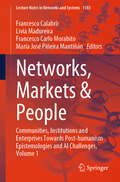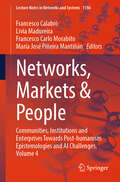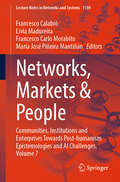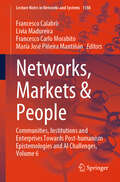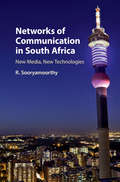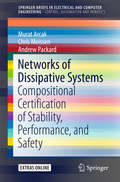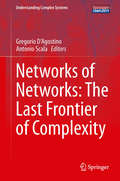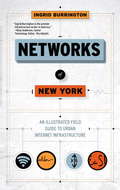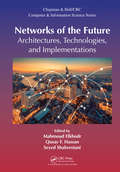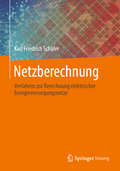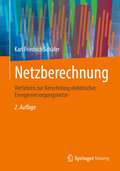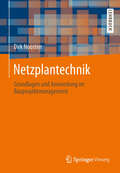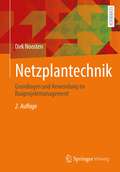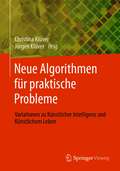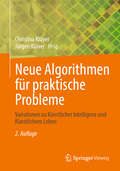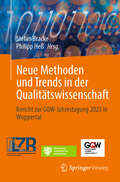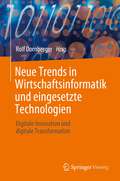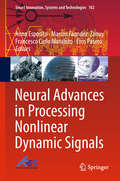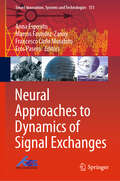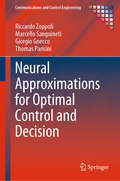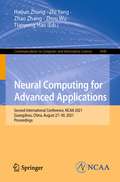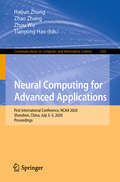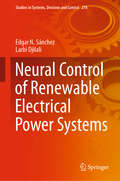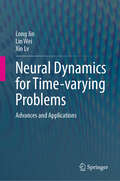- Table View
- List View
Networks, Markets & People: Communities, Institutions and Enterprises Towards Post-humanism Epistemologies and AI Challenges, Volume 1 (Lecture Notes in Networks and Systems #1183)
by Francesco Calabrò Livia Madureira Francesco Carlo Morabito María José Piñeira MantiñánThis book aims to address the issue of the effects that the contemporary environmental, technological, social and economic global challenges produce on settlement systems, communities, institutions and enterprises. It presents a multi-disciplinary scientific debate on the new frontiers of strategic and spatial planning, decision support tools and ecological design, within the urban-rural areas networks and the metropolitan cities of the Mediterranean basin. The book focuses on five topics: Cultural Heritage as driver of development for territories and tourism destinations; Ecosystems, people-nature cohesion and urban-rural relationships; Decision Support Systems for urban regeneration; Policies and practices of cohesion and social innovation for inclusive cities; Green buildings and sustainable solutions for ecological transition. In addition, the book hosts the papers of a special session intercluster promoted by Italian Society of Architectural Technology (SITdA). The book benefits all researchers, practitioners and policymakers interested in the issue applied to metropolitan cities and marginal areas.
Networks, Markets & People: Communities, Institutions and Enterprises Towards Post-humanism Epistemologies and AI Challenges, Volume 4 (Lecture Notes in Networks and Systems #1186)
by Francesco Calabrò Livia Madureira Francesco Carlo Morabito María José Piñeira MantiñánThis book aims to address the issue of the effects that the contemporary environmental, technological, social and economic global challenges produce on settlement systems, communities, institutions and enterprises. It presents a multi-disciplinary scientific debate on the new frontiers of strategic and spatial planning, decision support tools and ecological design, within the urban-rural areas networks and the metropolitan cities of the Mediterranean basin. The book focuses on five topics: Cultural Heritage as driver of development for territories and tourism destinations; Ecosystems, people-nature cohesion and urban-rural relationships; Decision Support Systems for urban regeneration; Policies and practices of cohesion and social innovation for inclusive cities; Green buildings and sustainable solutions for ecological transition. In addition, the book hosts the papers of a special session intercluster promoted by Italian Society of Architectural Technology (SITdA). The book benefits all researchers, practitioners and policymakers interested in the issue applied to metropolitan cities and marginal areas.
Networks, Markets & People: Communities, Institutions and Enterprises Towards Post-humanism Epistemologies and AI Challenges, Volume 7 (Lecture Notes in Networks and Systems #1189)
by Francesco Calabrò Livia Madureira Francesco Carlo Morabito María José Piñeira MantiñánThis book aims to address the issue of the effects that the contemporary environmental, technological, social and economic global challenges produce on settlement systems, communities, institutions and enterprises. It presents a multi-disciplinary scientific debate on the new frontiers of strategic and spatial planning, decision support tools and ecological design, within the urban-rural areas networks and the metropolitan cities of the Mediterranean basin. The book focuses on five topics: Cultural Heritage as driver of development for territories and tourism destinations; Ecosystems, people-nature cohesion and urban-rural relationships; Decision Support Systems for urban regeneration; Policies and practices of cohesion and social innovation for inclusive cities; Green buildings and sustainable solutions for ecological transition. In addition, the book hosts the papers of a special session intercluster promoted by Italian Society of Architectural Technology (SITdA). The book benefits all researchers, practitioners and policymakers interested in the issue applied to metropolitan cities and marginal areas.
Networks, Markets & People: Communities, Institutions and Enterprises Towards Post-humanism Epistemologies and AI Challenges, Volume 6 (Lecture Notes in Networks and Systems #1188)
by Francesco Calabrò Livia Madureira Francesco Carlo Morabito María José Piñeira MantiñánThis book aims to address the issue of the effects that the contemporary environmental, technological, social and economic global challenges produce on settlement systems, communities, institutions and enterprises. It presents a multi-disciplinary scientific debate on the new frontiers of strategic and spatial planning, decision support tools and ecological design, within the urban-rural areas networks and the metropolitan cities of the Mediterranean basin. The book focuses on five topics: Cultural Heritage as driver of development for territories and tourism destinations; Ecosystems, people-nature cohesion and urban-rural relationships; Decision Support Systems for urban regeneration; Policies and practices of cohesion and social innovation for inclusive cities; Green buildings and sustainable solutions for ecological transition. In addition, the book hosts the papers of a special session intercluster promoted by Italian Society of Architectural Technology (SITdA). The book benefits all researchers, practitioners and policymakers interested in the issue applied to metropolitan cities and marginal areas.
Networks, Markets & People: Communities, Institutions and Enterprises Towards Post-humanism Epistemologies and AI Challenges, Volume 3 (Lecture Notes in Networks and Systems #1185)
by Francesco Calabrò Livia Madureira Francesco Carlo Morabito María José Piñeira MantiñánThis book aims to address the issue of the effects that the contemporary environmental, technological, social and economic global challenges produce on settlement systems, communities, institutions and enterprises. It presents a multi-disciplinary scientific debate on the new frontiers of strategic and spatial planning, decision support tools and ecological design, within the urban-rural areas networks and the metropolitan cities of the Mediterranean basin. The book focuses on five topics: Cultural Heritage as driver of development for territories and tourism destinations; Ecosystems, people-nature cohesion and urban-rural relationships; Decision Support Systems for urban regeneration; Policies and practices of cohesion and social innovation for inclusive cities; Green buildings and sustainable solutions for ecological transition. In addition, the book hosts the papers of a special session intercluster promoted by Italian Society of Architectural Technology (SITdA). The book benefits all researchers, practitioners and policymakers interested in the issue applied to metropolitan cities and marginal areas.
Networks of Communication in South Africa: New Media, New Technologies
by R. SooryamoorthyWithin a short period of time, South Africa has made remarkable progress in the adoption of mobile and Internet technologies. In this landmark study, R. Sooryamoorthy examines the development of communication patterns, social contacts and networks in South Africa. Based on pioneering quantitative and qualitative data, he analyses trends in changing media use in Africa, showing the development of the use of new media for communication by South Africans of all ages, races and genders in relation to the development of media infrastructure, its cost and government policy. It shows how people use the media for communication purposes that affirm or break their social contacts and networks, and how they apply media to establish, re-establish or maintain social relationships. This book will be of interest to those researching the growth of communication technology in Africa, as well as those involved in the wider fields of development studies and economics.
Networks of Dissipative Systems
by Murat Arcak Chris Meissen Andrew PackardThis book addresses a major problem for today's large-scale networked systems: certification of the required stability and performance properties using analytical and computational models. On the basis of illustrative case studies, it demonstrates the applicability of theoretical methods to biological networks, vehicle fleets, and Internet congestion control. Rather than tackle the network as a whole --an approach that severely limits the ability of existing methods to cope with large numbers of physical components-- the book develops a compositional approach that derives network-level guarantees from key structural properties of the components and their interactions--the book addresses this problem by pursuing a compositional approach that derives network-level guarantees from key structural properties of the subsystems and their interactions. The foundational tool in this approach is the established dissipativity theory, which is reviewed in the first chapter and supplemented with modern computational techniques. The book blends this theory with the authors' recent research efforts at a level that is accessible to graduate students and practising engineers familiar with only the most basic nonlinear systems concepts. Code associated with the numerical examples can be downloaded at extras. springer. com, allowing readers to reproduce the examples and become acquainted with the relevant software.
Networks of Networks: The Last Frontier of Complexity
by Gregorio D'Agostino Antonio ScalaThe present work is meant as a reference to provide an organic and comprehensive view of the most relevant results in the exciting new field of Networks of Networks (NetoNets). Seminal papers have recently been published posing the basis to study what happens when different networks interact, thus providing evidence for the emergence of new, unexpected behaviors and vulnerabilities. From those seminal works, the awareness on the importance understanding Networks of Networks (NetoNets) has spread to the entire community of Complexity Science. The reader will benefit from the experience of some of the most well-recognized leaders in this field. The contents have been aggregated under four headings; General Theory, Phenomenology, Applications and Risk Assessment. The reader will be impressed by the different applications of the general paradigm that span from physiology, to financial risk, to transports. We are currently making the first steps to reduce the distance between the language and the way of thinking of the two communities of experts in real infrastructures and the complexity scientists. Although this path may prove to be long, it is extremely promising, both in extending our understanding of complex systems and in finding concrete applications that can enhance the life quality of millions of people.
Networks of New York: An Illustrated Field Guide to Urban Internet Infrastructure
by Ingrid BurringtonA guided tour of the physical Internet, as seen on, above, and below the city's streets What does the Internet look like? It's the single most essentail aspect of modern life, and yet, for many of us, the Internet looks like an open browser, or the black mirrors of our phones and computers. But in Networks of New York, Ingrid Burrington lifts our eyes from our screens to the streets, showing us that the Internet is everywhere around us, all the time--we just have to know where to look. Using New York as her point of reference and more than fifty color illustrations as her map, Burrington takes us on a tour of the urban network: She decodes spray-painted sidewalk markings, reveals the history behind cryptic manhole covers, shuffles us past subway cameras and giant carrier hotels, and peppers our journey with background stories about the NYPD's surveillance apparatus, twentieth-century telecommunication monopolies, high frequency trading on Wall Street, and the downtown building that houses the offices of both Google and the FBI's Joint Terrorism Task Force. From a rising star in the field of tech jounalism, Networks of New York is a smart, funny, and beautifully designed guide to the endlessly fascinating networks of urban Internet infrastructure. The Internet, Burrington shows us, is hiding in plain sight.From the Hardcover edition.
Networks of the Future: Architectures, Technologies, and Implementations (Chapman & Hall/CRC Computer and Information Science Series)
by Seyed Shahrestani Qusay F. Hassan Mahmoud ElkhodrWith the ubiquitous diffusion of the IoT, Cloud Computing, 5G and other evolved wireless technologies into our daily lives, the world will see the Internet of the future expand ever more quickly. Driving the progress of communications and connectivity are mobile and wireless technologies, including traditional WLANs technologies and low, ultra-power, short and long-range technologies. These technologies facilitate the communication among the growing number of connected devices, leading to the generation of huge volumes of data. Processing and analysis of such "big data" brings about many opportunities, as well as many challenges, such as those relating to efficient power consumptions, security, privacy, management, and quality of service. This book is about the technologies, opportunities and challenges that can drive and shape the networks of the future. Written by established international researchers and experts, Networks of the Future answers fundamental and pressing research challenges in the field, including architectural shifts, concepts, mitigation solutions and techniques, and key technologies in the areas of networking. The book starts with a discussion on Cognitive Radio (CR) technologies as promising solutions for improving spectrum utilization, and also highlights the advances in CR spectrum sensing techniques and resource management methods. The second part of the book presents the latest developments and research in the areas of 5G technologies and Software Defined Networks (SDN). Solutions to the most pressing challenges facing the adoption of 5G technologies are also covered, and the new paradigm known as Fog Computing is examined in the context of 5G networks. The focus next shifts to efficient solutions for future heterogeneous networks. It consists of a collection of chapters that discuss self-healing solutions, dealing with Network Virtualization, QoS in heterogeneous networks, and energy efficient techniques for Passive Optical Networks and Wireless Sensor Networks. Finally, the areas of IoT and Big Data are discussed, including the latest developments and future perspectives of Big Data and the IoT paradigms.
Netzberechnung: Verfahren zur Berechnung elektrischer Energieversorgungsnetze
by Karl Friedrich SchäferElektrische Energieversorgungsnetze sind wesentliche Bausteine bei der Umgestaltung der Energieversorgungssysteme im Rahmen der Energiewende. Dieses Buch beschreibt die spezifischen Modelle und Berechnungsmethoden für diese Netze.
Netzberechnung: Verfahren zur Berechnung elektrischer Energieversorgungsnetze
by Karl Friedrich SchäferElektrische Energieversorgungsnetze sind wesentliche Bausteine bei der Umgestaltung der Energieversorgungssysteme im Rahmen der Energiewende. Bei der Planung und dem Betrieb dieser Netze wird eine Vielzahl mathematischer Methoden als unverzichtbare Hilfsmittel eingesetzt. Dieses Buch beschreibt die spezifischen Modelle und Berechnungsalgorithmen für elektrische Energieversorgungsnetze.
Netzplantechnik: Grundlagen und Anwendung im Bauprojektmanagement
by Dirk NoostenDer Planung, Steuerung und Überwachung von Bauprojekten kommt mit zunehmender Größe eine wachsende Bedeutung zu. Für sehr komplexe Abläufe mit vielen Abhängigkeiten bieten sich Netzpläne an. Das grundlegende Verständnis der Netzplantechnik ist Voraussetzung für die fehlerfreie Anwendung von Projektmanagement-Software. Das Werk führt detailliert in die Technik der Netzplanerstellung und das zeitliche Management von Bauprojekten ein. Eine Umfangreiche Sammlung von Beispiel- und Lösungsaufgaben runden das Werk ab.
Netzplantechnik: Grundlagen und Anwendung im Bauprojektmanagement
by Dirk NoostenDer Planung, Steuerung und Überwachung von Bauprojekten kommt mit zunehmender Größe eine wachsende Bedeutung zu. Für sehr komplexe Abläufe mit vielen Abhängigkeiten bieten sich Netzpläne an. Das grundlegende Verständnis der Netzplantechnik ist Voraussetzung für die fehlerfreie Anwendung von Projektmanagement-Software. Das Werk führt detailliert in die Technik der Netzplanerstellung und das zeitliche Management von Bauprojekten ein. Darüber hinaus wird die Entstehung und Aussagekraft von kritischen Wegen ausführlich dargestellt. Insbesondere mit Blick auf die Verursachung von Bauablaufstörungen wird gezeigt, dass nicht jede Verzögerung auf dem kritischen Weg zwangsläufig zu einer Bauzeitverlängerung führen muss. Eine Umfangreiche Sammlung von Beispiel- und Lösungsaufgaben runden das Werk ab.
Neue Algorithmen für praktische Probleme: Variationen zu Künstlicher Intelligenz und Künstlichem Leben
by Christina Klüver Jürgen KlüverIn diesem Sammelband geht es darum, neue Algorithmen aus den Bereichen der Künstlichen Intelligenz (KI) und des Künstlichen Lebens (KL) und deren praktische Anwendung zu zeigen. Der wesentliche Aspekt des Bandes ist, dass in den Beiträgen exemplarisch gezeigt wird, dass und wie diese neuen Algorithmen auf praktische Probleme in sehr verschiedenen Bereichen erfolgreich eingesetzt werden können: Von der Modellierung sozialer Aspekte in der Softwareentwicklung bis zur Entscheidungsunterstützung, welche Start- und Landebahn an einem Flughafen ausgewählt werden soll; von der Analyse von Krankheitsverläufen bis zur Auswahl und Optimierung technischer Systeme, sowie Alternativen für die Bildbearbeitung.
Neue Algorithmen für praktische Probleme: Variationen zu Künstlicher Intelligenz und Künstlichem Leben
by Christina Klüver Jürgen KlüverIn diesem Sammelband geht es darum, neue Algorithmen aus den Bereichen der Künstlichen Intelligenz (KI) und des Künstlichen Lebens (KL) und deren praktische Anwendung zu zeigen. Der wesentliche Aspekt des Bandes ist, dass in den Beiträgen exemplarisch gezeigt wird, dass und wie diese neuen Algorithmen auf praktische Probleme in sehr verschiedenen Bereichen erfolgreich eingesetzt werden können: Von der Modellierung betrieblicher Abläufe und des Managements bis zur Entscheidungsunterstützung bei der Wahl der Start- und Landebahn eines Flughafens, von der Analyse von Sensordaten bis zur Überwachung, Auswahl und Optimierung technischer Systeme sowie Alternativen für die Bildverarbeitung.
Neue Methoden und Trends in der Qualitätswissenschaft: Bericht zur GQW-Jahrestagung 2023 in Wuppertal
by Stefan Bracke Philipp HeßZielsetzung der Gesellschaft für Qualitätswissenschaft e.V. ist es, die Qualitätswissenschaft in Lehre und Forschung zu fördern und den Wissenstransfer in die industrielle Anwendung zu unterstützen. Dies erfolgt unter anderem durch Pflege des wissenschaftlichen Erfahrungsaustauschs unter den auf diesem Gebiet tätigen Personen und Institutionen und der Verbreitung von Forschungs- und Entwicklungsergebnissen sowie der Unterstützung des Wissenstransfers zwischen Forschung und Praxis. Die Entwicklung von technisch komplexen Produkten, Prozessen sowie neuen Dienstleistungen erfolgt auf Basis stetig expandierender Wertschöpfungsnetzwerke in einem turbulenten Marktumfeld. Anforderungen von Kunden und Märkten an Funktionalität, Zuverlässigkeit und Sicherheit nehmen zu, wobei die Wertschöpfung auf viele Kooperationspartner verteilt wird und deren Vernetzung im nationalen und internationalen Kontext stetig ansteigt. Des Weiteren führt die zunehmende Digitalisierung von Produkten und Unternehmensprozessen dazu, dass die Verfügbarkeit von Entwicklungsdaten, Produktionsprozessdaten sowie Betriebsdaten zu einem exponentiellen Daten- und Informationsvolumen führt. Dies stellt gleichermaßen Herausforderung und Potential für die Qualitätswissenschaften dar. Unter dem Leitthema „Neue Methoden und Trends in der Qualitätswissenschaft“ hat die Gesellschaft für Qualitätsmanagement gemeinsam mit der Bergischen Universität Wuppertal zur GQW Tagung 2023 eingeladen. Wir freuen uns, dass wir Ihnen nun den zugehörigen Tagungsband vorstellen können.
Neue Trends in Wirtschaftsinformatik und eingesetzte Technologien: Digitale Innovation und digitale Transformation
by Rolf DornbergerDieses Buch stellt ausgewählte Beispiele der Digitalisierung im Zeitalter des digitalen Wandels vor. Es gliedert sich in die zwei Abschnitte "Digitale Innovation", in dem neue Technologien vorgestellt werden, die neue Geschäftsmöglichkeiten anregen und ermöglichen, und "Digitale Transformation", in dem Geschäfts- und Managementkonzepte vorgestellt werden, die spezifische technologische Lösungen für ihre praktische Umsetzung nutzen. Das Buch kombiniert neue Erkenntnisse aus Forschung, Lehre und Management, einschließlich digitaler Business-Transformation, E-Business, Wissensdarstellung, Mensch-Computer-Interaktion und Geschäftsoptimierung, und zeigt eine Bandbreite von Forschungsthemen sowie deren anwendungsorientierte Umsetzung in die Praxis auf. Es richtet sich an Akademiker und Akademikerinnen, die Inspiration suchen, sowie an Führungskräfte, die das Potenzial der neuesten Trends nutzen wollen, um die Gesellschaft und Unternehmen auf die nächste Stufe zu heben.
Neural Advances in Processing Nonlinear Dynamic Signals (Smart Innovation, Systems and Technologies #102)
by Anna Esposito Marcos Faundez-Zanuy Francesco Carlo Morabito Eros PaseroThis book proposes neural networks algorithms and advanced machine learning techniques for processing nonlinear dynamic signals such as audio, speech, financial signals, feedback loops, waveform generation, filtering, equalization, signals from arrays of sensors, and perturbations in the automatic control of industrial production processes. It also discusses the drastic changes in financial, economic, and work processes that are currently being experienced by the computational and engineering sciences community.Addresses key aspects, such as the integration of neural algorithms and procedures for the recognition, the analysis and detection of dynamic complex structures and the implementation of systems for discovering patterns in data, the book highlights the commonalities between computational intelligence (CI) and information and communications technologies (ICT) to promote transversal skills and sophisticated processing techniques.This book is a valuable resource fora. The academic research communityb. The ICT marketc. PhD students and early stage researchersd. Companies, research institutese. Representatives from industry and standardization bodies
Neural Approaches to Dynamics of Signal Exchanges (Smart Innovation, Systems and Technologies #151)
by Anna Esposito Marcos Faundez-Zanuy Francesco Carlo Morabito Eros PaseroThe book presents research that contributes to the development of intelligent dialog systems to simplify diverse aspects of everyday life, such as medical diagnosis and entertainment. Covering major thematic areas: machine learning and artificial neural networks; algorithms and models; and social and biometric data for applications in human–computer interfaces, it discusses processing of audio-visual signals for the detection of user-perceived states, the latest scientific discoveries in processing verbal (lexicon, syntax, and pragmatics), auditory (voice, intonation, vocal expressions) and visual signals (gestures, body language, facial expressions), as well as algorithms for detecting communication disorders, remote health-status monitoring, sentiment and affect analysis, social behaviors and engagement. Further, it examines neural and machine learning algorithms for the implementation of advanced telecommunication systems, communication with people with special needs, emotion modulation by computer contents, advanced sensors for tracking changes in real-life and automatic systems, as well as the development of advanced human–computer interfaces. The book does not focus on solving a particular problem, but instead describes the results of research that has positive effects in different fields and applications.
Neural Approximations for Optimal Control and Decision (Communications and Control Engineering)
by Giorgio Gnecco Thomas Parisini Riccardo Zoppoli Marcello SanguinetiNeural Approximations for Optimal Control and Decision provides a comprehensive methodology for the approximate solution of functional optimization problems using neural networks and other nonlinear approximators where the use of traditional optimal control tools is prohibited by complicating factors like non-Gaussian noise, strong nonlinearities, large dimension of state and control vectors, etc. Features of the text include: • a general functional optimization framework; • thorough illustration of recent theoretical insights into the approximate solutions of complex functional optimization problems; • comparison of classical and neural-network based methods of approximate solution; • bounds to the errors of approximate solutions; • solution algorithms for optimal control and decision in deterministic or stochastic environments with perfect or imperfect state measurements over a finite or infinite time horizon and with one decision maker or several; • applications of current interest: routing in communications networks, traffic control, water resource management, etc.; and • numerous, numerically detailed examples. The authors’ diverse backgrounds in systems and control theory, approximation theory, machine learning, and operations research lend the book a range of expertise and subject matter appealing to academics and graduate students in any of those disciplines together with computer science and other areas of engineering.
Neural Computing for Advanced Applications: Second International Conference, NCAA 2021, Guangzhou, China, August 27-30, 2021, Proceedings (Communications in Computer and Information Science #1449)
by Haijun Zhang Zhi Yang Zhao Zhang Zhou Wu Tianyong HaoThis book presents refereed proceedings of the Second International Conference Neural Computing for Advanced Applications, NCAA 2021, held in Guangzhou, China, in August, 2021. The 54 full papers papers were thorougly reviewed and selected from a total of 144 qualified submissions. The papers are organized in topical sections on neural network theory, cognitive sciences, neuro-system hardware implementations, and NN-based engineering applications; machine learning, data mining, data security and privacy protection, and data-driven applications; neural computing-based fault diagnosis, fault forecasting, prognostic management, and system modeling; computational intelligence, nature-inspired optimizers, and their engineering applications; fuzzy logic, neuro-fuzzy systems, decision making, and their applications in management sciences; control systems, network synchronization, system integration, and industrial artificial intelligence; computer vision, image processing, and their industrial applications; cloud/edge/fog computing, the Internet of Things/Vehicles(IoT/IoV), and their system optimization; spreading dynamics, forecasting, and other intelligent techniques against coronavirus disease (COVID-19).
Neural Computing for Advanced Applications: First International Conference, NCAA 2020, Shenzhen, China, July 3–5, 2020, Proceedings (Communications in Computer and Information Science #1265)
by Haijun Zhang Zhao Zhang Tianyong Hao Zhou WuThis book presents refereed proceedings of the First International Conference Neural Computing for Advanced Applications, NCAA 2020, held in July, 2020. Due to the COVID-19 pandemic the conference was held online. The 36 full papers and 7 short papers were thorougly reviewed and selected from a total of 113 qualified submissions. Thes papers present resent research on such topics as neural network theory, and cognitive sciences, machine learning, data mining, data security & privacy protection, and data-driven applications, computational intelligence, nature-inspired optimizers, and their engineering applications, cloud/edge/fog computing, the Internet of Things/Vehicles (IoT/IoV), and their system optimization, control systems, network synchronization, system integration, and industrial artificial intelligence, fuzzy logic, neuro-fuzzy systems, decision making, and their applications in management sciences, computer vision, image processing, and their industrial applications, and natural language processing, machine translation, knowledge graphs, and their applications.
Neural Control of Renewable Electrical Power Systems (Studies in Systems, Decision and Control #278)
by Edgar N. Sánchez Larbi DjilaliThis book presents advanced control techniques that use neural networks to deal with grid disturbances in the context renewable energy sources, and to enhance low-voltage ride-through capacity, which is a vital in terms of ensuring that the integration of distributed energy resources into the electrical power network. It presents modern control algorithms based on neural identification for different renewable energy sources, such as wind power, which uses doubly-fed induction generators, solar power, and battery banks for storage. It then discusses the use of the proposed controllers to track doubly-fed induction generator dynamics references: DC voltage, grid power factor, and stator active and reactive power, and the use of simulations to validate their performance. Further, it addresses methods of testing low-voltage ride-through capacity enhancement in the presence of grid disturbances, as well as the experimental validation of the controllers under both normal and abnormal grid conditions. The book then describes how the proposed control schemes are extended to control a grid-connected microgrid, and the use of an IEEE 9-bus system to evaluate their performance and response in the presence of grid disturbances. Lastly, it examines the real-time simulation of the entire system under normal and abnormal conditions using an Opal-RT simulator.
Neural Dynamics for Time-varying Problems: Advances and Applications
by Long Jin Lin Wei Xin LvThis book mainly presents methods based on neural dynamics for the time-varying problems with applications, together with the corresponding theoretical analysis, simulative examples, and physical experiments. Based on these methods, their applications include motion planning of redundant manipulators, filter design, winner-take-all operation, multiple-input multiple-output system configuration, multi-linear tensor equation solving, and manipulability optimization are also presented. In this book, we present the design, proposal, development, analysis, modeling, and simulation of various neural dynamic models, along with their respective applications including motion planning of redundant manipulators, filter design, winner-take-all operation, multiple-input multiple-output system configuration, multi-linear tensor equation solving, and manipulability optimization. Specifically, starting from the top-level considerations of hardware implementation, we integrate computational intelligence methods and control theory to design a series of dynamic and noise-resistant discrete neural dynamic methods. The research work not only owns the theoretical guarantee on its convergence, noise resistance, and accuracy, but demonstrate the effectiveness and robustness in solving various optimization and equation solving problems, particularly in handling time-varying problems and noise perturbations. Moreover, by reducing complexity and avoiding matrix inversion operations, the models’ feasibility and practicality are further enhanced.
